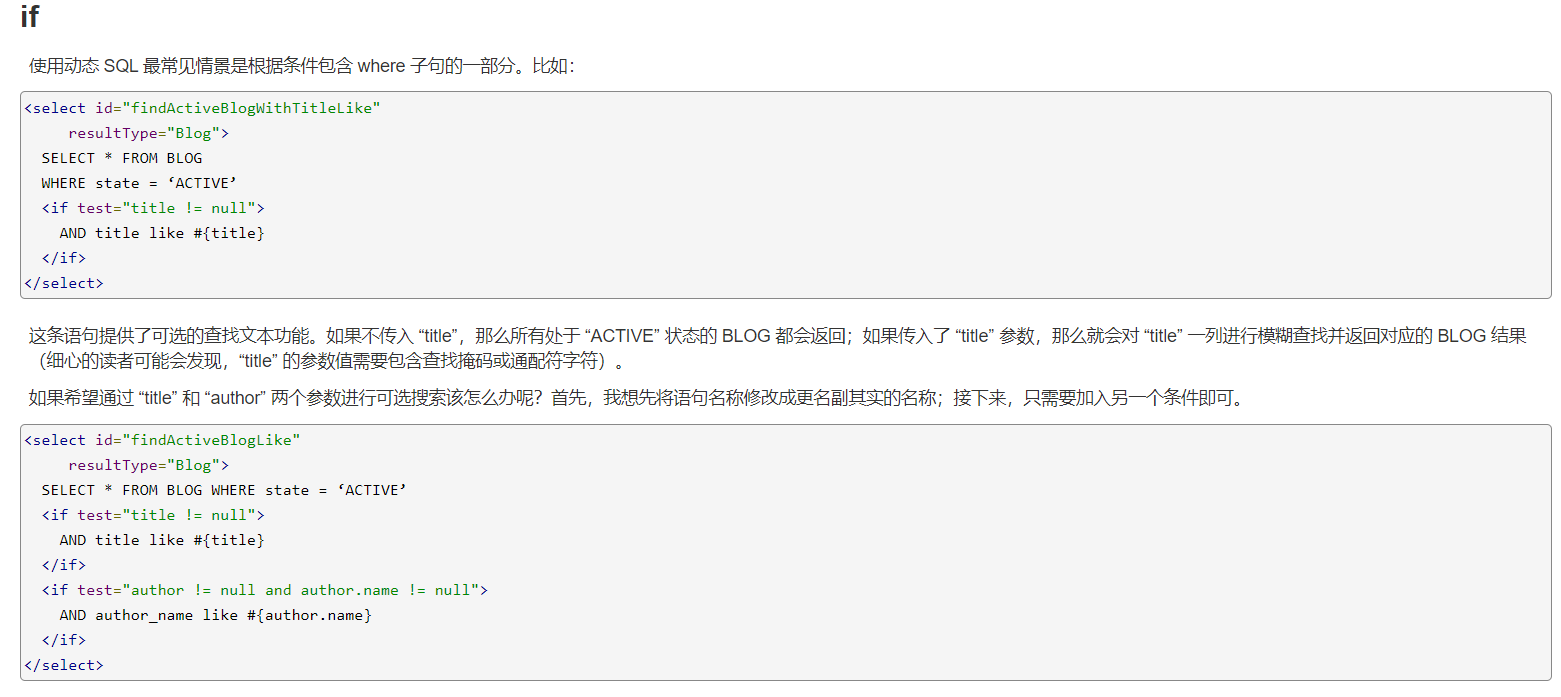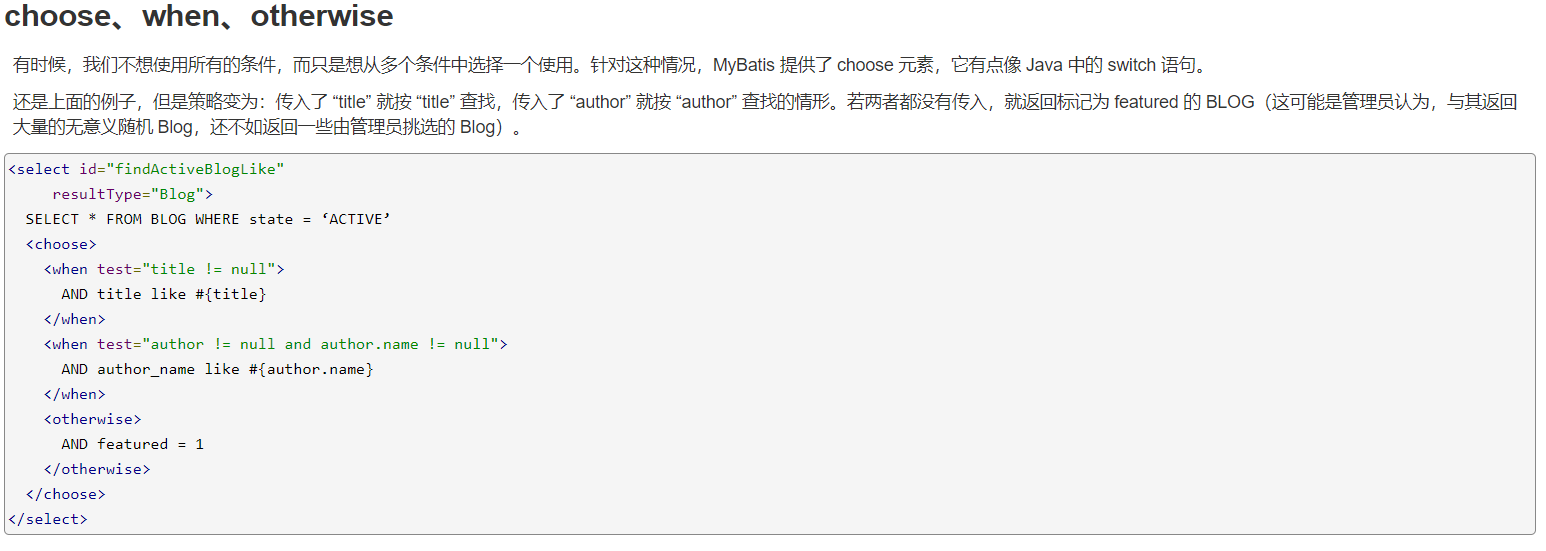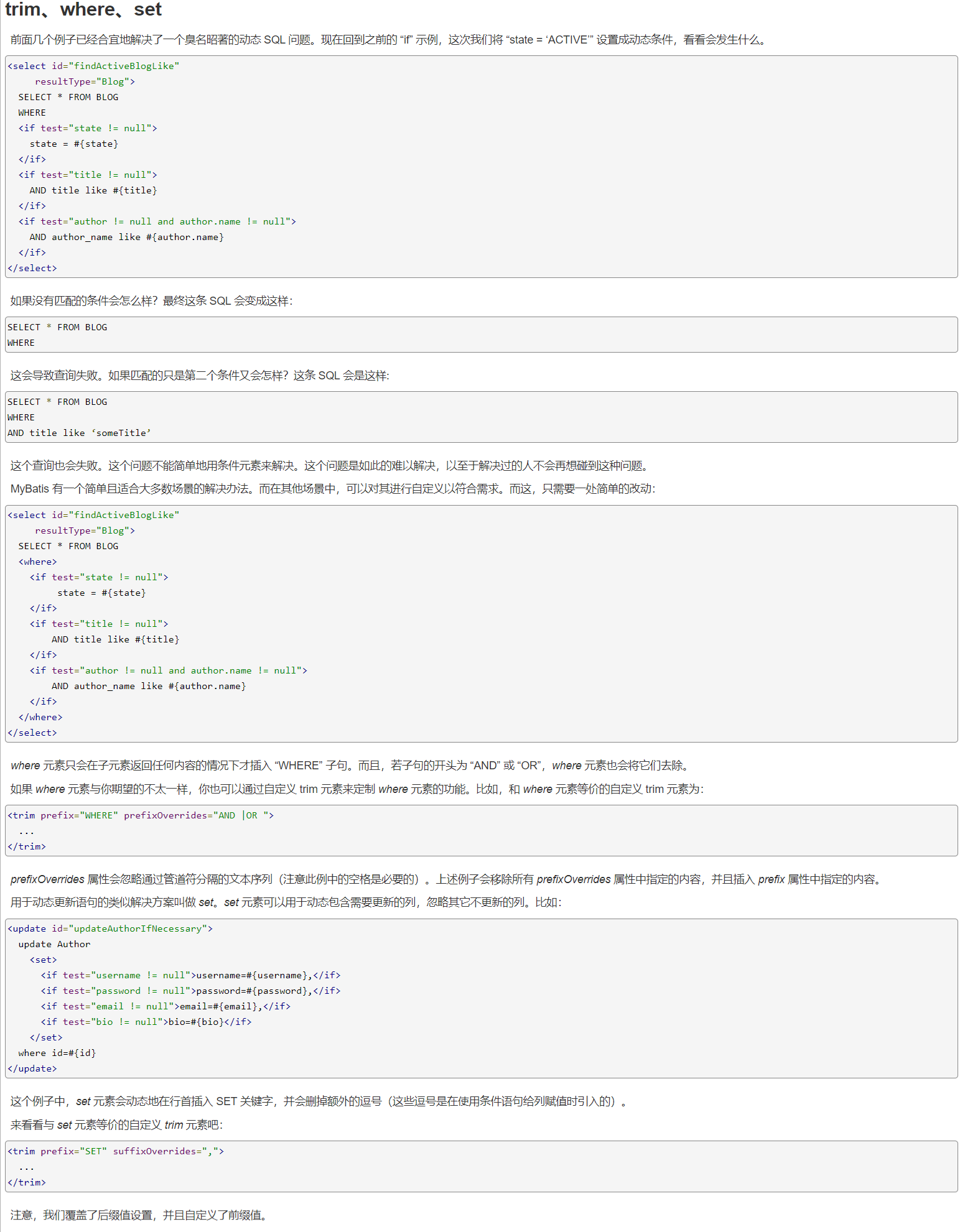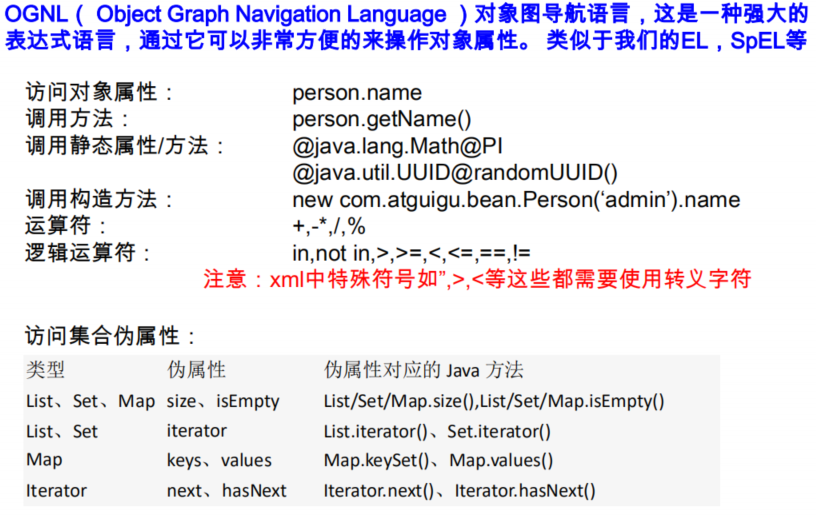1.动态SQL简介
动态 SQL是MyBatis强大特性之一.
动态 SQL 元素和使用 JSTL 或其他类似基于 XML 的文本处理器相似.
MyBatis 采用功能强大的基于 OGNL 的表达式来简化操作.

2.if

1).实现DynamicSQL

public interface EmployeeMapperDynamicSQL {
public List<Employee> getEmpsByCondtionIf(Employee employee);
}
<mapper namespace="com.atguigu.mybatis.dao.EmployeeMapperDynamicSQL">
<!-- 查询员工:携带指定字段查询条件就带上该字段的值 -->
<!-- public List<Employee> getEmpsByCondtionIf(Employee employee) -->
<select id="getEmpsByCondtionIf" resultType="com.atguigu.mybatis.bean.Employee">
select * from tbl_employee
<!-- where:根据条件包含 where 子句 -->
where
<!-- test:判断表达式(OGNL) -->
<!-- OGNL语法参照PPT或者官方文档:http://commons.apache.org/proper/commons-ognl/language-guide.html -->
<!-- 从参数中取值进行判断,如果遇到特殊符号去写转义字符,查W3C HTML ISO-8859-1 参考手册 -->
<if test="id!=null">
id=#{id}
</if>
<!-- <if test="lastName!=null and lastName!="""> -->
<!-- <if test="lastName!=null && lastName!=''"> -->
<if test="lastName!=null && lastName!=""">
and last_name like #{lastName}
</if>
<if test="email!=null and email.trim()!=""">
and email=#{email}
</if>
<!-- ognl会进行字符串与数字的转换判断 "0"==0 -->
<if test="gender==0 or gender==1">
and gender=#{gender}
</if>
</select>
</mapper>
// select * from tbl_employee WHERE id=? and last_name like ? and email=?
// Employee employee = new Employee(3, "%e%","atguigu@atguigu.com", null);
//select * from tbl_employee WHERE id=? and last_name like ?
Employee employee = new Employee(null, "%e%",null, null);
List<Employee> emps = mapper.getEmpsByCondtionIf(employee);
for(Employee emp:emps) {
System.out.println(emp);
}
2.choose
有时候,我们不想使用所有的条件,而只是想从多个条件中选择一个使用.针对这种情况,MyBatis 提供了 choose 元素,它有点像 Java 中的 switch 语句.

public List<Employee> getEmpByConditionChoose(Employee employee);
<mapper namespace="com.atguigu.mybatis.dao.EmployeeMapperDynamicSQL">
<!-- public List<Employee> getEmpByConditionChoose(Employee employee) -->
<select id="getEmpByConditionChoose" resultType="com.atguigu.mybatis.bean.Employee">
select * from tbl_employee
<where>
<!-- 如果带了id就用id查,如果带了lastName就用lastName查;只会进入其中一个 -->
<choose>
<when test="id!=null">
id=#{id}
</when>
<when test="lastName!=null">
last_name like #{lastName}
</when>
<when test="email!=null">
email = #{email}
</when>
<otherwise>
gender = 0
</otherwise>
</choose>
</where>
</select>
</mapper>
//测试choose
Employee employee = new Employee(3, "%e%",null, null);
List<Employee> list = mapper.getEmpByConditionChoose(employee);
for(Employee emp:list) {
System.out.println(emp);
}
3.trim
1).where

public List<Employee> getEmpsByCondtionTrim(Employee employee);
<mapper namespace="com.atguigu.mybatis.dao.EmployeeMapperDynamicSQL">
<!-- public List<Employee> getEmpsByCondtionTrim(Employee employee) -->
<select id="getEmpsByCondtionTrim" resultType="com.atguigu.mybatis.bean.Employee">
select * from tbl_employee
<!-- 后面多出的and或者or where标签不能解决,我们使用trim定制where元素功能 -->
<!-- 自定义字符串的截取规则 -->
<!-- trim:根据条件包含 where 子句 -->
<!-- trim标签体中是整个字符串拼串 后的结果 -->
<!-- 通过自定义 trim 元素来定制 where 元素的功能 -->
<!-- prefix:前缀;prefix给拼串后的整个字符串加一个前缀 如:where <===> <trim prefix="where"> -->
<!-- prefixOverrides:前缀覆盖;去掉整个字符串前面多余的字符 -->
<!-- suffix:后缀;suffix给拼串后的整个字符串加一个后缀 -->
<!-- suffixOverrides:后缀覆盖;去掉整个字符串后面多余的字符 -->
<trim prefix="where" suffixOverrides="and">
<if test="id!=null">
id=#{id} and
</if>
<if test="lastName!=null && lastName!=""">
last_name like #{lastName} and
</if>
<if test="email!=null and email.trim()!=""">
email=#{email} and
</if>
<!-- ognl会进行字符串与数字的转换判断 "0"==0 -->
<if test="gender==0 or gender==1">
gender=#{gender}
</if>
</trim>
</select>
</mapper>
@Test
public void testDynamicSql() throws IOException {
SqlSessionFactory sqlSessionFactory = getSqlSessionFactory();
SqlSession openSession = sqlSessionFactory.openSession();
try {
EmployeeMapperDynamicSQL mapper = openSession.getMapper(EmployeeMapperDynamicSQL.class);
// select * from tbl_employee WHERE id=? and last_name like ? and email=?
// Employee employee = new Employee(3, "%e%","atguigu@atguigu.com", null);
//select * from tbl_employee WHERE id=? and last_name like ?
Employee employee = new Employee(3, "%e%",null, null);
List<Employee> emps = mapper.getEmpsByCondtionIf(employee);
for(Employee emp:emps) {
System.out.println(emp);
}
//查询的时候如果某些条件没带可能sql拼装会有问题
//1、给where后面加上1=1,以后的条件都and xxx.
//2、mybatis使用where标签来将所有的查询条件包括在内。
//mybatis就会将where标签中拼装的sql,多出来的and或者or去掉
//where只会去掉第一个多出来的and或者or。
//测试Trim
List<Employee> emps2 = mapper.getEmpsByCondtionTrim(employee);
for(Employee emp:emps2) {
System.out.println(emp);
}
} finally {
// : handle finally clause
openSession.close();
}
}
2).set
①.使用set更新
public void updateEmp(Employee employee);
<mapper namespace="com.atguigu.mybatis.dao.EmployeeMapperDynamicSQL">
<update id="updateEmp">
<!-- set:更新拼串 -->
<!-- set标签的使用 -->
update tbl_employee
<set>
<if test="lastName!=null">
last_name=#{lastName},
</if>
<if test="email!=null">
email=#{email},
</if>
<if test="gender!=null">
gender=#{gender}
</if>
</set>
where id=#{id}
</update>
</mapper>
//调试set标签 Employee employee = new Employee(1, "Adminn",null, null); mapper.updateEmp(employee); openSession.commit();
②.使用trim拼串更新
public void updateEmp(Employee employee);
<mapper namespace="com.atguigu.mybatis.dao.EmployeeMapperDynamicSQL">
<!-- public void updateEmp(Employee employee) -->
<update id="updateEmp">
<!-- Trim:更新拼串 -->
update tbl_employee
<trim prefix="set" suffixOverrides=",">
<if test="lastName!=null">
last_name=#{lastName},
</if>
<if test="email!=null">
email=#{email},
</if>
<if test="gender!=null">
gender=#{gender}
</if>
</trim>
where id=#{id}
</update>
</mapper>
//调试set标签 Employee employee = new Employee(1, "Adminn",null, null); mapper.updateEmp(employee); openSession.commit();
4.foreach

动态 SQL 的另外一个常用的必要操作是需要对一个集合进行遍历,通常是在构建 IN 条件语句的时候.

当迭代列表、集合等可迭代对象或者数组时;index是当前迭代的次数,item的值是本次迭代获取的元素.
当使用字典(或者Map.Entry对象的集合)时,index是键,item是值.
1).MySQL
(1).遍历记录
//查询员工id'在给定集合中的
public List<Employee> getEmpsByConditionForeach(@Param("ids")List<Integer> ids);
<mapper namespace="com.atguigu.mybatis.dao.EmployeeMapperDynamicSQL">
<!-- public List<Employee> getEmpsByConditionForeach(List<Integer> ids) -->
<select id="getEmpsByConditionForeach" resultType="com.atguigu.mybatis.bean.Employee">
<!-- collection:指定要遍历的集合;list类型的参数会特殊处理封装在map中,map的key就是list -->
<!-- item:当前遍历出的元素赋值给指定的变量 -->
<!-- separator:每个元素之间的分隔符 -->
<!-- open:遍历出所有结果拼接一个开始的字符 -->
<!-- close:遍历出所有结果拼接一个结束的字符 -->
<!-- index:索引;遍历list的时候是index就是索引,item就是当前值;遍历map的时候index表示的就是map的key,item就是map的值 -->
<!-- #{变量名}:能取出变量的值也就是当前遍历出的元素 -->
select * from tbl_employee
<foreach collection="ids" item="item_id" separator="," open="where id in(" close=")">
#{item_id}
</foreach>
</select>
</mapper>
//测试foreach
List<Employee> list = mapper.getEmpsByConditionForeach(Arrays.asList(1,2,3,4));
for(Employee emp : list) {
System.out.println(emp);
}
(2).批量保存记录1
public void addEmps(@Param("emps")List<Employee> emps);
<mapper namespace="com.atguigu.mybatis.dao.EmployeeMapperDynamicSQL">
<!-- 批量保存数据 -->
<!-- MySQL下批量保存:可以foreach遍历 mysql支持values(),(),()语法 -->
<!-- public void addEmps(@Param("emps")List<Employee> emps) -->
<!-- insert 方式一 -->
<!-- 推荐使用inert 方式一 -->
<insert id="addEmps">
insert into tbl_employee(last_name,email,gender,d_id)
values
<foreach collection="emps" item="emp" separator=",">
(#{emp.lastName},#{emp.email},#{emp.gender},#{emp.dept.id})
</foreach>
</insert>
</mapper>
List<Employee> emps = new ArrayList<>(); emps.add(new Employee(null, "smith", "smith@atguigu.com", "1",new Department(1))); emps.add(new Employee(null, "allen", "allen@atguigu.com", "0",new Department(1))); mapper.addEmps(emps); openSession.commit();
(3).批量保存记录2
public void addEmps(@Param("emps")List<Employee> emps);
<mapper namespace="com.atguigu.mybatis.dao.EmployeeMapperDynamicSQL">
<!-- insert 方式二 -->
<!-- public void addEmps(@Param("emps")List<Employee> emps) -->
<!-- 这种方式需要数据库连接属性allowMultiQueries=true;
这种分号分隔多个sql可以用于其他的批量操作(删除,修改) -->
<insert id="addEmps">
<foreach collection="emps" item="emp" separator=";">
insert into tbl_employee(last_name,email,gender,d_id)
values(#{emp.lastName},#{emp.email},#{emp.gender},#{emp.dept.id})
</foreach>
</insert>
</mapper>
List<Employee> emps = new ArrayList<>(); emps.add(new Employee(null, "smith", "smith@atguigu.com", "1",new Department(1))); emps.add(new Employee(null, "allen", "allen@atguigu.com", "0",new Department(1))); mapper.addEmps(emps); openSession.commit();
2).Oracle
(1).批量保存1
<mapper namespace="com.atguigu.mybatis.dao.EmployeeMapperDynamicSQL">
<insert id="addEmps" databaseId="oracle">
<!-- oracle第一种批量方式 -->
<!-- <foreach collection="emps" item="emp" open="begin" close="end;">
insert into employees(employee_id,last_name,email)
values(employees_seq.nextval,#{emp.lastName},#{emp.email});
</foreach>
</insert>
</mapper>
(2).批量保存2
<mapper namespace="com.atguigu.mybatis.dao.EmployeeMapperDynamicSQL">
<insert id="addEmps" databaseId="oracle">
<!-- oracle第二种批量方式 -->
insert into employees(
<!-- 引用外部定义的sql -->
<include refid="insertColumn">
<property name="testColomn" value="abc"/>
</include>
)
<foreach collection="emps" item="emp" separator="union"
open="select employees_seq.nextval,lastName,email from("
close=")">
select #{emp.lastName} lastName,#{emp.email} email from dual
</foreach>
</insert>
</mapper>
5.bind
bind 元素可以从 OGNL 表达式中创建一个变量并将其绑定到上下文.

1).bind
若在 mybatis 配置文件中配置了 databaseIdProvider , 则可以使用 “_databaseId”变量,这样就可以根据不同的数据库厂商构建特定的语句.
public List<Employee> getEmpsTestInnerParameter(Employee employee);
<mapper namespace="com.atguigu.mybatis.dao.EmployeeMapperDynamicSQL">
<!-- public List<Employee> getEmpsTestInnerParameter(Employee employee) -->
<!-- mybatis默认还有两个内置参数:_parameter|_databaseId -->
<!-- _parameter:代表整个参数;单个参数:_parameter就是这个参数;多个参数:参数会被封装为一个map,_parameter就是代表这个map -->
<!-- _databaseId:如果配置了databaseIdProvider标签;_databaseId就是代表当前数据库的别名 -->
<select id="getEmpsTestInnerParameter" resultType="com.atguigu.mybatis.bean.Employee">
<!-- bind:可以将OGNL表达式的值绑定到一个变量中,方便后来引用这个变量的值 -->
<if test="_databaseId=='mysql'">
select * from tbl_employee
<if test="_parameter!=null">
where last_name like #{lastName}
</if>
</if>
<if test="_databaseId=='oracle'">
select * from employees
<if test="_parameter!=null">
where last_name like #{_parameter.lastName}
</if>
</if>
</select>
</mapper>
@Test
public void testInnerParam() throws IOException{
SqlSessionFactory sqlSessionFactory = getSqlSessionFactory();
SqlSession openSession = sqlSessionFactory.openSession();
try{
EmployeeMapperDynamicSQL mapper = openSession.getMapper(EmployeeMapperDynamicSQL.class);
Employee employee2 = new Employee();
employee2.setLastName("%e%");
List<Employee> list = mapper.getEmpsTestInnerParameter(employee2);
for (Employee employee : list) {
System.out.println(employee);
}
}finally{
openSession.close();
}
}
2).SQL片段
public void addEmps(@Param("emps")List<Employee> emps);
<mapper namespace="com.atguigu.mybatis.dao.EmployeeMapperDynamicSQL">
<!-- insert 方式三 -->
<insert id="addEmps">
insert into tbl_employee(
<include refid="insertColumn"></include>
)
values
<foreach collection="emps" item="emp" separator=",">
(#{emp.lastName},#{emp.email},#{emp.gender},#{emp.dept.id})
</foreach>
</insert>
<!-- 抽取可重用的sql片段;方便后面引用 -->
<!-- 1、sql抽取:经常将要查询的列名,或者插入用的列名抽取出来方便引用 -->
<!-- 2、include来引用已经抽取的sql -->
<!-- 3、include还可以自定义一些property,sql标签内部就能使用自定义的属性 -->
<!-- include-property:取值的正确方式${prop} #{不能使用这种方式} -->
<sql id="insertColumn">
<if test="_databaseId=='oracle'">
employee_id,last_name,email
</if>
<if test="_databaseId=='mysql'">
last_name,email,gender,d_id
</if>
</sql>
</mapper>
@Test
public void testBatchSave() throws IOException {
SqlSessionFactory sqlSessionFactory = getSqlSessionFactory();
SqlSession openSession = sqlSessionFactory.openSession();
try {
EmployeeMapperDynamicSQL mapper = openSession.getMapper(EmployeeMapperDynamicSQL.class);
List<Employee> emps = new ArrayList<>();
emps.add(new Employee(null, "smith", "smith@atguigu.com", "1",new Department(1)));
emps.add(new Employee(null, "allen", "allen@atguigu.com", "0",new Department(1)));
mapper.addEmps(emps);
openSession.commit();
}finally {
openSession.close();
}
}
6.OGNL

参考文档:http://commons.apache.org/proper/commons-ognl/language-guide.html